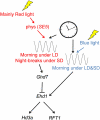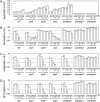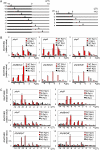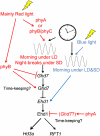Molecular dissection of the roles of phytochrome in photoperiodic flowering in rice
- PMID: 21880933
- PMCID: PMC3252176
- DOI: 10.1104/pp.111.181792
Molecular dissection of the roles of phytochrome in photoperiodic flowering in rice
Abstract
Phytochromes mediate the photoperiodic control of flowering in rice (Oryza sativa), a short-day plant. Recent molecular genetics studies have revealed a genetic network that enables the critical daylength response of florigen gene expression. Analyses using a rice phytochrome chromophore-deficient mutant, photoperiod sensitivity5, have so far revealed that within this network, phytochromes are required for expression of Grain number, plant height and heading date7 (Ghd7), a floral repressor gene in rice. There are three phytochrome genes in rice, but the roles of each phytochrome family member in daylength response have not previously been defined. Here, we revealed multiple action points for each phytochrome in the critical daylength response of florigen expression by using single and double phytochrome mutant lines of rice. Our results show that either phyA alone or a genetic combination of phyB and phyC can induce Ghd7 mRNA, whereas phyB alone causes some reduction in levels of Ghd7 mRNA. Moreover, phyB and phyA can affect Ghd7 activity and Early heading date1 (a floral inducer) activity in the network, respectively. Therefore, each phytochrome gene of rice has distinct roles, and all of the phytochrome actions coordinately control the critical daylength response of florigen expression in rice.
Figures






Similar articles
-
Post-transcriptional regulation of Ghd7 protein stability by phytochrome and OsGI in photoperiodic control of flowering in rice.New Phytol. 2019 Oct;224(1):306-320. doi: 10.1111/nph.16010. Epub 2019 Jul 19. New Phytol. 2019. PMID: 31225911
-
Genetic Relationship Between Phytochromes and OsELF3-1 Reveals the Mode of Regulation for the Suppression of Phytochrome Signaling in Rice.Plant Cell Physiol. 2019 Mar 1;60(3):549-561. doi: 10.1093/pcp/pcy225. Plant Cell Physiol. 2019. PMID: 30476313
-
Analysis of PHOTOPERIOD SENSITIVITY5 sheds light on the role of phytochromes in photoperiodic flowering in rice.Plant Physiol. 2009 Oct;151(2):681-90. doi: 10.1104/pp.109.139097. Epub 2009 Aug 12. Plant Physiol. 2009. PMID: 19675157 Free PMC article.
-
Molecular control of seasonal flowering in rice, arabidopsis and temperate cereals.Ann Bot. 2014 Nov;114(7):1445-58. doi: 10.1093/aob/mcu032. Epub 2014 Mar 20. Ann Bot. 2014. PMID: 24651369 Free PMC article. Review.
-
The coincidence of critical day length recognition for florigen gene expression and floral transition under long-day conditions in rice.Mol Plant. 2013 May;6(3):635-49. doi: 10.1093/mp/sst022. Epub 2013 Feb 15. Mol Plant. 2013. PMID: 23416454 Review.
Cited by
-
Molecular mechanisms underlying phytochrome-controlled morphogenesis in plants.Nat Commun. 2019 Nov 19;10(1):5219. doi: 10.1038/s41467-019-13045-0. Nat Commun. 2019. PMID: 31745087 Free PMC article. Review.
-
The G123 rice mutant, carrying a mutation in SE13, presents alterations in the expression patterns of photosynthetic and major flowering regulatory genes.PLoS One. 2020 May 18;15(5):e0233120. doi: 10.1371/journal.pone.0233120. eCollection 2020. PLoS One. 2020. PMID: 32421736 Free PMC article.
-
Se14, encoding a JmjC domain-containing protein, plays key roles in long-day suppression of rice flowering through the demethylation of H3K4me3 of RFT1.PLoS One. 2014 Apr 23;9(4):e96064. doi: 10.1371/journal.pone.0096064. eCollection 2014. PLoS One. 2014. PMID: 24759811 Free PMC article.
-
PHYTOCHROME C is an essential light receptor for photoperiodic flowering in the temperate grass, Brachypodium distachyon.Genetics. 2014 Sep;198(1):397-408. doi: 10.1534/genetics.114.166785. Epub 2014 Jul 14. Genetics. 2014. PMID: 25023399 Free PMC article.
-
Involvement of CONSTANS-like Proteins in Plant Flowering and Abiotic Stress Response.Int J Mol Sci. 2023 Nov 22;24(23):16585. doi: 10.3390/ijms242316585. Int J Mol Sci. 2023. PMID: 38068908 Free PMC article. Review.
References
-
- Borthwick HA. (1964) Phytochrome action and its time displays. Am Nat 98: 347–355
Publication types
MeSH terms
Substances
LinkOut - more resources
Full Text Sources

